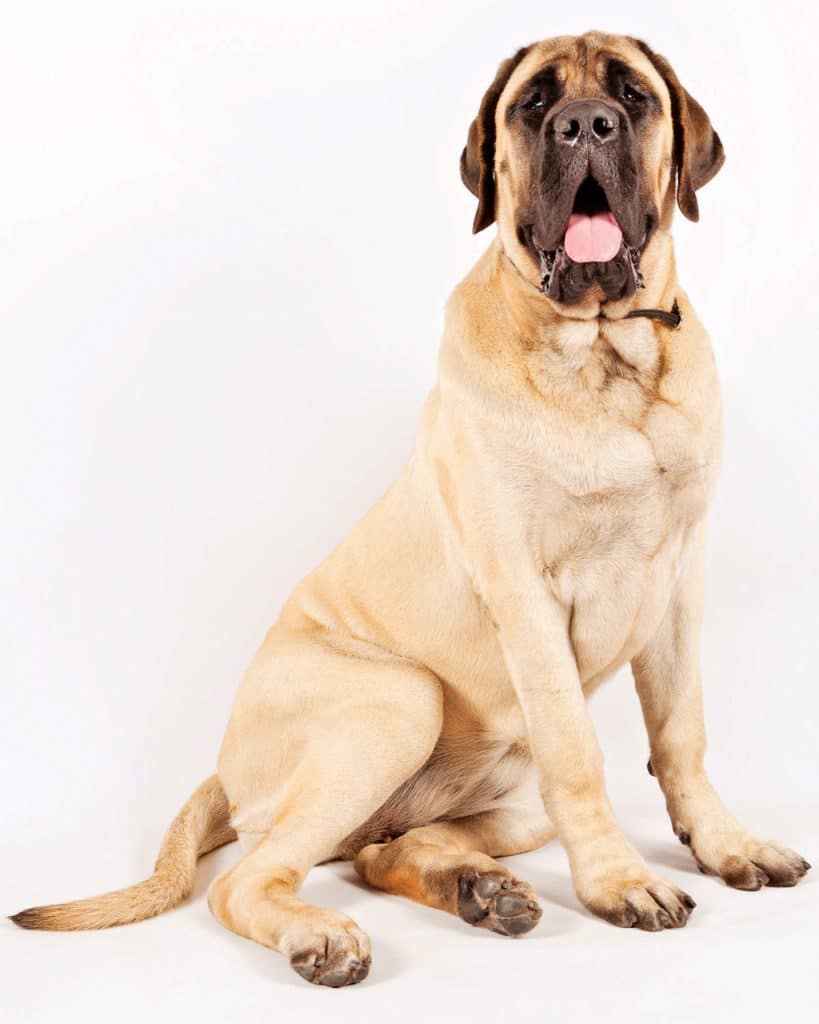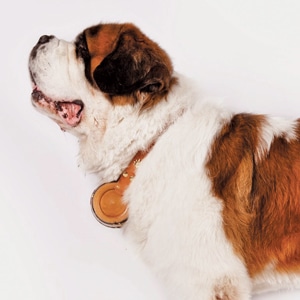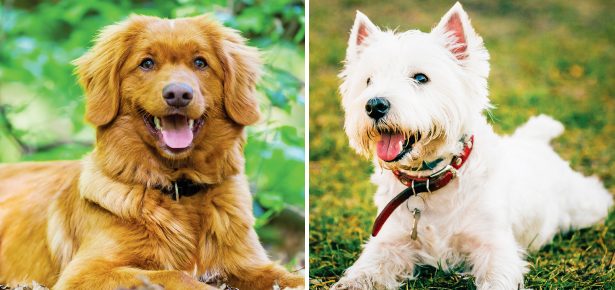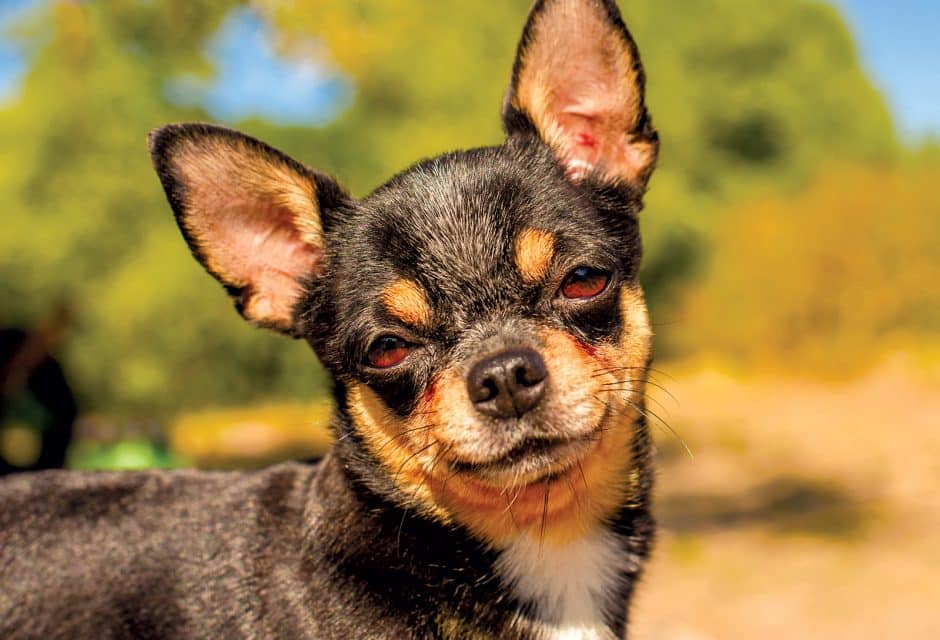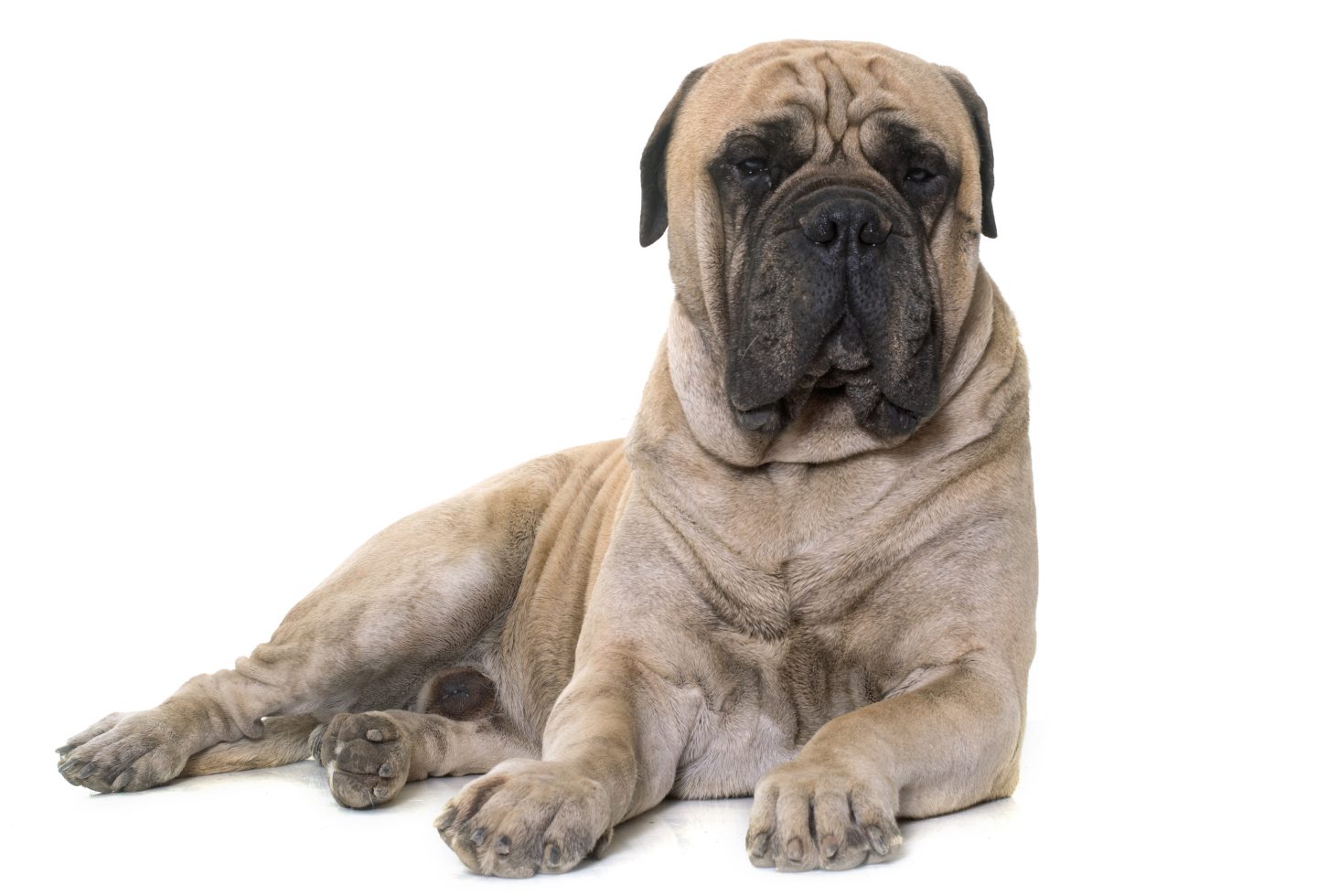
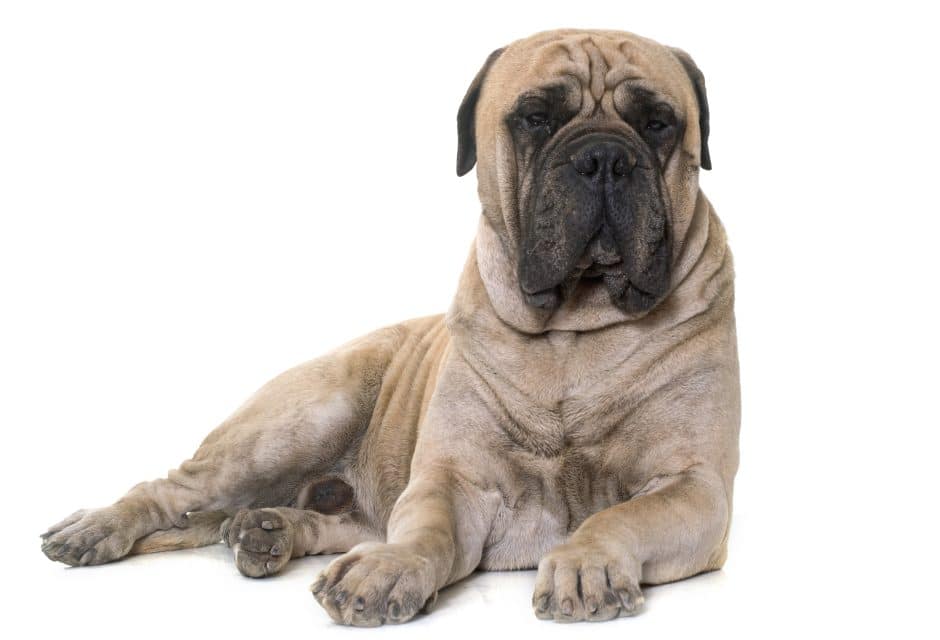
The Mastiff
The tough-looking exterior of this BIG dog—the largest of the giant breeds—disguises an inner softie. Is the Mastiff right for you? Read on to find out…

What we have here is possibly the dog world’s biggest contradiction—because underneath all of that power and muscle is one of the sweetest, most sensitive, and loving members of the canine world.
With his massive, muscular body and ferocious-sounding bark, the Mastiff can strike fear in the hearts of men. Of the giant breeds, he is the largest (as defined by body mass—this breed is not only big but heavy) and can clock in at well over 200 pounds. But what we have here is possibly the dog world’s biggest contradiction—because underneath all of that power and muscle is one of the sweetest, most sensitive, and loving members of the canine world.
Where did these gentle giants originate?
The Mastiff descended from the ancient Alaunt and Molosser, giant hunting and guarding dogs whose Tolkien-sounding names befit their antiquity (think B.C.). From here, the Mastiff was developed over many thousands of years. Artwork from the Babylonian era depicts lion-hunting dogs that, other than being thinner and taller than Mastiffs, bear striking similarity to today’s breed. Egyptian drawings feature dogs of this type as far back as 3000 BC.
Pictorial evidence aside, however, what exists with regard to the breed’s earliest development is essentially folklore–but what interesting folklore it is! Phoenician traders are thought to have brought Mastiffs to England, where they were subsequently taken by Romans during Caesar’s invasion in 55 BC. Caesar is said to have brought a large number of Mastiffs back to Italy for guard work and to fight in the arenas. Marco Polo wrote of the 5,000 Mastiffs held in the kennel of Kubla Khan, used for fighting and war assistance.
Ultimately, though, the majority of the breed’s development occurred in England, dating as far back as the fifteenth century. Then, poverty and hunger were epidemic among the commoners, and thievery and poaching for food were rampant as a result. The nobles, with plentiful food and game on their land, could afford to feed a massive dog and used the Mastiff to scare away those who trespassed on their land in search of food or game.
By the early 20th century, the Mastiff’s numbers had dwindled in England, but fanciers worked to sustain the breed, introducing the St. Bernard into the mix. Breed popularity soared but the Mastiff’s future would face another hurdle. During the Second World War, many large breeds faced the possibility of extinction. In a time when people were starving, it was seen as an excess (and downright unpatriotic) to house and feed a giant dog. The Mastiff’s numbers plummeted.
In the late 1940s, a dedicated group of British fanciers took matters into their own hands, and made it their mission to revive the breed. Records show that, by this time, there were only seven Mastiffs alive in England! The situation was dire, so off to America the breeders went, in pursuit of suitable breeding stock. (The breed was introduced to America in the 1800s and recognized by the American Kennel Club (AKC) in 1885.) Ultimately, two puppies were imported into England and those dogs would become the foundation stock needed to save the breed. Other breeds with similar physical traits and temperaments were selectively introduced, including the Bullmastiff, the Great Dane, and the St. Bernard.
Today’s Mastiff is a family companion. Looking for a guard dog? The Mastiff will not fit the bill. While these dogs will protect their families, it is more a case of watching over their flock rather than fighting for it. Typically, you’ll be alerted when someone comes to the door by a bark—a very loud and ferocious-sounding bark, I might add. But once folks are in your home and your Mastiff sees that you have accepted them, that’ll be good enough for him.
The Mastiff is a true house dog. He will not respond well to periods of extended time away from you. These dogs bond very closely with their guardians and certainly fit the classic description of a Velcro dog—the kind who literally sticks to you all the time. If you value independence and time alone, this isn’t the breed for you. You will find that the Mastiff wants to be beside you and, likely, on you. His paw may find itself on your leg, his massive head in your lap, or he may be a leaner who likes to plop his sizable rump on your foot. One way or another, the Mastiff will make his way into your personal space. To deprive a Mastiff of this kind of closeness would be to deprive him of his strongest instinct because, for the Mastiff, to know you is to love you. So please let him.
This breed is well known for being kind and patient with children. Due to his size, though, safety and common sense are urged when small children are near. A 200-plus pound dog can knock over a toddler quite easily with a gentle nudge or a happily-swinging tail.
In terms of energy-level and exercise requirements, the Mastiff is calm and easy to live with. A moderate daily walk will keep him happy. That being said, the eager to please Mastiff is up for some activities, if you’re game. Mastiffs have done very well in canine sports like Obedience, Rally, Agility, and Carting. Their sweet disposition has also made them notoriously good Therapy dogs.
Now, about the slobber.
Well, Mastiff fanciers will tell you a few things. First, they’ll quickly point out that the Mastiff is not the biggest culprit for slobber-slinging in the dog world. There are droolier breeds! But some slobber is a fact of daily life and, especially after eating or drinking, a wipe with a towel will be needed to keep drool in check. Mastiff owners typically have small towels placed strategically around their homes, in their cars, etc. And you may surprise yourself, because plenty of Mastiff devotees not only say that slobber is a small price to pay for life with the gentle giant, but admit they’ve learned to love those big, wet kisses.
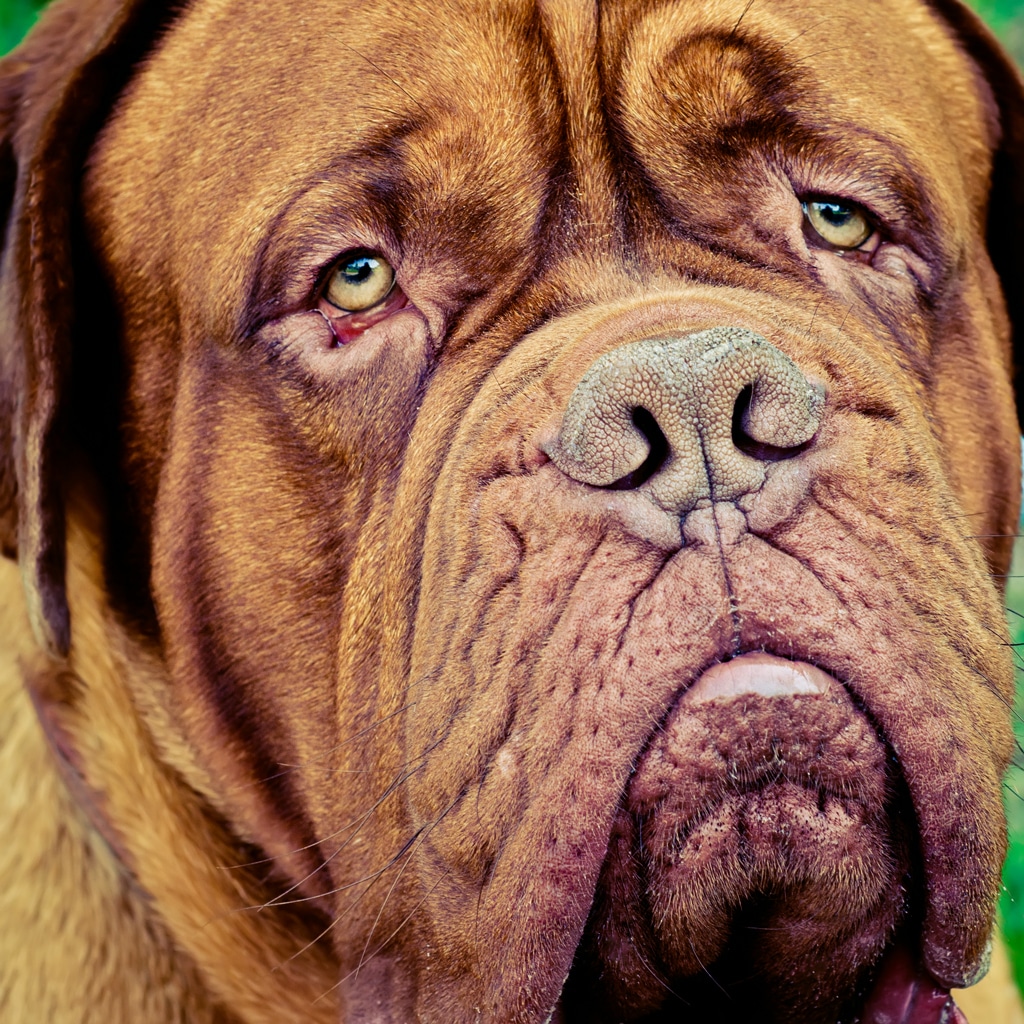
gorielov/Bigstock
Profile: The Mastiff
Size: Giant
The AKC standard includes a minimum height requirement of 27.5 inches at the shoulder. Weight is not addressed in the standard, but most males weigh from 160 to 230 pounds and females at 120 to 170 pounds.
Activity Level: 2/5
The easy-going Mastiff does not require a great deal of exercise, and you may even have to work at convincing him to get off the couch. Daily walks will suffice.
Grooming: 2/5
A weekly brush is all that’s required to keep this breed’s short coat looking dapper and shedding minimally. Keep those toenails filed down, so this massive breed doesn’t slip and fall.
Heritage:
Originally, the Mastiff used his massive size to protect his owners and for service in battle. Today, his role is that of devoted family companion.
For more information on Mastiff rescue in the U.S., visit www.mastiff.org/rescue/. In Canada, visit www.mastiffcanada.org.
As with most Giant breeds, there are some bottom-line considerations that come into play when you’re thinking about opening up your home to a Mastiff.
First, bigger dogs can translate into higher costs. Once past their growing stage, Mastiffs will typically eat between six to eight cups of food for day—that’s roughly 40 to 70 pounds per month. Veterinary expenses are also going to come at a premium in some cases, since many medications are dosed based upon weight.
But perhaps most important is to factor in the commitment that absolutely must be dedicated to obedience training. Life with an unruly 200-pound dog is not going to work out well, so it’s critical that obedience training begins when the Mastiff is in his early puppy stage. Establishing proper boundaries is very important, for everything from walking calmly on-leash to greeting people without jumping up or sitting quietly for a nail trim. The Mastiff can be quite shy and he is known to have a stubborn streak. These traits, too, can and should be worked on with training from an early age. As always, be sure to find a trainer who emphasizes only positive reinforcement techniques. This sensitive breed will respond particularly poorly to harsh or negative training.
Health-wise, the Mastiff is known as a hearty breed but like all dogs can be prone to some disorders, including hip and elbow dysplasia, cancer, and eye disorders. Some of these issues are hereditary; others are not. If working with a breeder, be sure to do your research to choose a reputable one whose dogs come with health clearances.
The Mastiff isn’t a dog you see every day, and that’s rather a shame. We live in such complicated times that many people would likely find a perfect companion in this easy-going, calm-natured breed. Cuddling up with the dog world’s biggest softy feels like a quiet port in a storm.
If you like the Mastiff, you might also consider the:
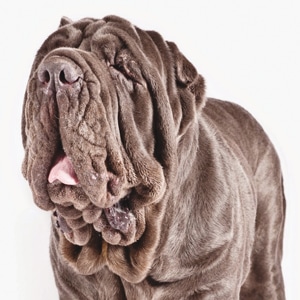
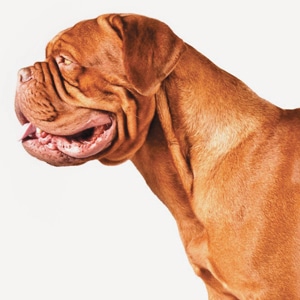
Neapolitan Mastiff Dogue de Bordeaux St. Bernard
» Read Your Breed For more breed profiles, go to moderndogmagazine.com/breeds
This article originally appeared in the award-winning Modern Dog magazine. Subscribe today!
Join the newsletter and never miss out on dog content again!
"*" indicates required fields
By clicking the arrow, you agree to our web Terms of Use and Privacy & Cookie Policy. Easy unsubscribe links are provided in every email.
